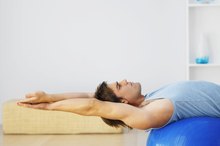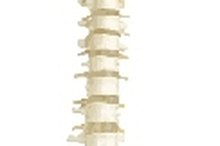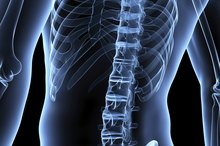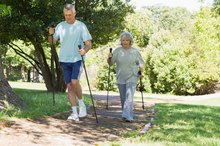Exercise Therapy for Severe Degenerative Disc Disease L5-S1
Degenerative disc disease (DDD) can be a confusing diagnosis, says Dr. Peter Ullrich, Jr., at Spine-Health.com. Not truly a disease or necessarily progressive in nature, DDD, is a degenerative process that affects the discs between your spinal vertebrae. Genetics, activity level, age, past injuries or traumas can all contribute to this condition. The lumbar spine or lower back is most-often impacted, due to greater amounts of force transmitted through this area. Exercise can improve the symptoms related to DDD.
Warning
With severe DDD, the nerves of the spine can be compromised. If your condition includes radiating symptoms, such as pain or numbness in your buttock, hips, legs or feet, you should exercise with caution. Any activity that increases these peripheral symptoms should be avoided. Prolonged nerve compromise can lead to permanent damage and should be monitored closely by a physician or physical therapist.
- With severe DDD, the nerves of the spine can be compromised.
Considerations
Exercise Ball for Sciatica Relief
Learn More
Your back will not tolerate extreme positions when severe DDD is present. Full extension, such as that which occurs when you arch or bend your back, will be the most aggravating to your symptoms and should be avoided. When severe DDD is present, there can be compromise of the space available for the nerves that exit the spine. Positions that further close these spaces can increase nerve compression. Lumbar extension, side bending and trunk rotation that occur together will close these spaces the most.
- Your back will not tolerate extreme positions when severe DDD is present.
- Full extension, such as that which occurs when you arch or bend your back, will be the most aggravating to your symptoms and should be avoided.
Neutral Spine
Exercises for this condition should be performed in a neutral spinal position. This means that the normal, stable spinal curvatures are maintained during exercise. This position is the safest position to exercise in. Normally, there is a small arch in the lower back. To check your posture, lift your breast bone upward, without arching your back, until some pressure is felt in the mid-back. Back off from this position slightly, and tighten your lower abdominal muscles by drawing your belly button inward.
- Exercises for this condition should be performed in a neutral spinal position.
- To check your posture, lift your breast bone upward, without arching your back, until some pressure is felt in the mid-back.
Spinal Stabilization
Symptoms of Thoracic Spine Pain
Learn More
The focus of exercise initially, should be to stabilize the spine by developing your deep core muscles. These include the transverse abdominis, pelvic floor muscles and the multifidi. These crucial muscles become inhibited in response to pain and weaken. Tighten your pelvic floor muscles and draw your belly button inward, away from your belt buckle. Use this contraction as a base for all exercise to increase spinal stability. In a patient resource, published by Rick Jemmett, P.T., called "Spinal Stabilization: The New Science of Back Pain," he reviews a self-directed core stabilization program with extensive patient education.
- The focus of exercise initially, should be to stabilize the spine by developing your deep core muscles.
Expert Insight
Exercise, done safely and correctly, can help reduce the symptoms associated with severe degenerative disc disease. The amount of benefit is determined by the degree of severity. Often, your symptoms will not be completely resolved. Improving spinal stability will help reduce the intensity and frequency of symptoms, giving you greater control over your condition.
- Exercise, done safely and correctly, can help reduce the symptoms associated with severe degenerative disc disease.
- Improving spinal stability will help reduce the intensity and frequency of symptoms, giving you greater control over your condition.
Related Articles
References
- Spine-Health.com: What is Degenerative Disc Disease?
- Lurie J, Tomkins-lane C. Management of lumbar spinal stenosis. BMJ. 2016;352:h6234. doi:10.1136/bmj.h623
- Delitto A, Piva SR, Moore CG, et al. Surgery versus nonsurgical treatment of lumbar spinal stenosis: a randomized trial. Ann Intern Med. 2015;162(7):465-473. doi:10.7326/M14-1420
- Mann SJ, Singh P. McKenzie back exercises. StatPearls [Internet]. Updated April 1, 2019.
- Padmanabhan G, Sambasivan A, Desai MJ. Three-step treadmill test and McKenzie mechanical diagnosis and therapy to establish directional preference in a patient with lumbar spinal stenosis: a case report. J Man Manip Ther. 2011;19(1):35-41. doi:10.1179/2042618610Y.0000000002
- Tousignant-laflamme Y, Longtin C, Brismée JM. How radiological findings can help or hinder patients' recovery in the rehabilitation management of patients with low back pain: what can clinicians do? J Man Manip Ther. 2017;25(2):63-65. doi:10.1080/10669817.2017.1309345
- McKenzie, R., & May, S. (2003). The lumbar spine mechanical diagnosis and therapy. (2nd ed., Vol. One). Waikanae: Spinal Publications New Zealand.
Resources
- "Spinal Stabilization: The New Science of Back Pain"; Rick Jemmett, P.T.; 2003
Writer Bio
Calling the Rocky Mountains home, Julie Warren has been writing since 2009. She has published in "American Beauty" magazine and has lectured and presented specialty areas of sports medicine. Warren holds a Bachelor of Science in physical therapy and a Bachelor of Science in physical and health education from McMaster University in Ontario, Canada.









